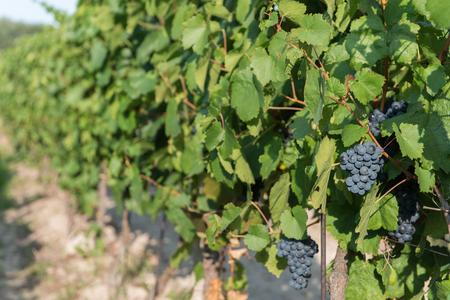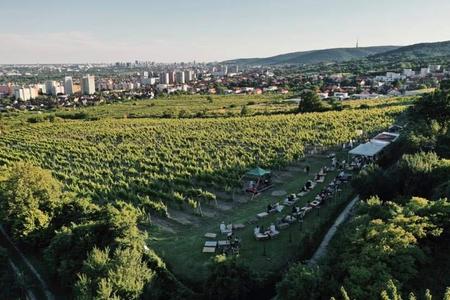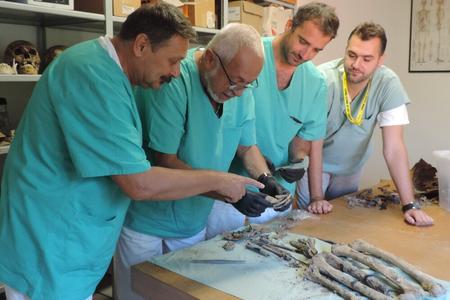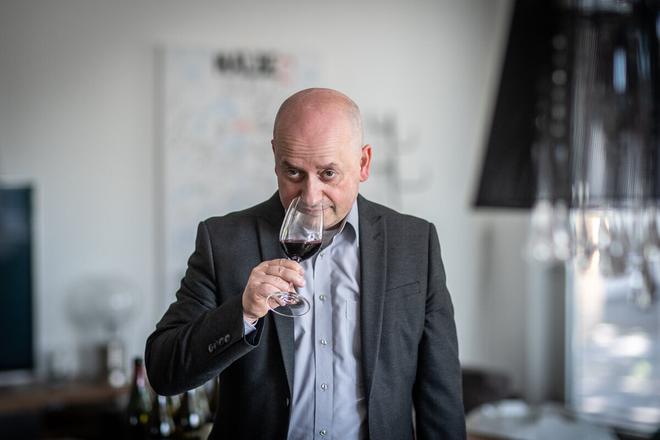Although Slovakia has only 8,500 cultivated hectares of vineyards, winegrowers can make remarkable wines from them. However, due to high input costs, they are only very slowly switching to more environmentally friendly grape growing.
"The quality of wine reflects the quality of a vineyard itself," said experienced sommelier Rastislav Šuták.
Did the pandemic affect the lives of winemakers and the wine business?
Yes. Almost everything has changed. The perception of wine has shifted from personal to online. People were forced to buy wine on the internet.
Wine is a specific product that will be very difficult to sell as a dowel or goods, the parametres of which you can find on a website and choose what suits you accordingly. This is not possible with wine. There is lack of a personal approach, the possibility of tasting and the like.Wine is a specific product that will be very difficult to sell as a dowel or goods, the parametres of which you can find on a website and choose what suits you accordingly. This is not possible with wine. There is lack of a personal approach, the possibility of tasting and the like.
But at the same time, people began to value wine more. They began to think more about it. And because they had more time, they also had the opportunity to taste more expensive wines. Those need more attention. On the other hand, many people have switched to hard liquor.
How did the coronavirus crisis affect wines from 2020?
In terms of Slovak wines, the year 2020 was not good. Stocks in some wineries have remained higher than in previous years. The wineries that did not have a problem with sales have now felt this significantly. They may not have a problem to survive, but the pandemic year has certainly had a negative effect.
Rastislav Šuták
Corner & Co (WinePlanet) sommelier
vice president of the Association of Sommeliers of Slovakia (ASSR)
lecturer of the ASSR's educational platform
three-time quarter-finalist of the World and European Sommelier Championships
20 years of experience working in gastronomy
On the other hand, wines from this vintage are lighter and simpler, so customers may consume them faster. Perhaps because of the relaxation of measures, people will open one or two bottles of such wine much more spontaneously.
What can wineries do with full storehouses and barrels before the new season?
As they will need free capacity for the year 2021, they will probably sell them significantly below the price in the retail network. In some countries, surpluses are distilled. There is no such practice in Slovakia.
You have mentioned the retail network. What wine offer can a consumer find on supermarket shelves?
As much as 85 percent of wine sold in Slovakia is sold in retail, and for a Slovak the financial ceiling for a bottle is about €4. And that is a pretty low price for a quality product. The structure of wines is not focused on quality, but on price. But there are also more ambitious supermarkets that try to supplement the range with better wines, which are, however, mostly from abroad.
How do we choose wine in the supermarket?
Due to the structure, I would remain a patriot and I would choose something from a proven Slovak producer. It may not be brilliant, but it will be solid wine. A customer at the supermarket is more likely to go wrong when choosing wine from foreign brands rather than Slovak brands.
How can a bottle of Australian or Chilean wine in supermarkets cost €3?
It's simple. The conditions for growing vines in these countries are diametrically more favourable than in Slovakia. In the local vineyards you can harvest mechanically, which significantly reduces costs.

The risk of microclimatic changes, such as frost, is not so significant, so the production of a vineyard is much higher. And even at higher yields, they can grow grapes of solid quality. This in turn reduces its price. In Chile, you can buy a kilogram of grapes of local varieties for wine production for about €0.08 - €0.10, which is absolutely unimaginable for us. In Slovakia, it is €0.30 - €0.50 per kilogram, which, in my opinion, is still a very low price.
On the other hand, Chilean or Australian wine for €3 is not a product you will have a philosophical debate over. These are simple wines for daily consumption at lunch or dinner.
Recently, various organic, natural, naked or even vegan wines have come into fashion. Is it just marketing or do winemakers really grow greener here?
The idea of such wines is very old. We have a winery in our portfolio that has not used any chemicals, not even sulphur, for a hundred years. Since 2000, the most significant changes in climate change have been observed right in viticulture.
Several studies show that the easiest way to protect vineyards is to switch to organic farming. In Austria, 14 percent of vineyards are in bio or organic mode and eight to ten percent are in transition. In Slovakia, if I am not mistaken, we have six producers who have certified bio grapes, which is a negligible amount.
Vegan and low-histamine wines are a trend more related to the current fashion and lifestyle of a part of society. I would not compare them to organic wines. I do not think wine should be a demonstration of certificates. The best wines are those that are created in an organic fashion, but you do not know it at all.
Is there a debate in Slovak viticulture about the climate and the transition to organic farming?
Of course, and many producers are slowly switching to this method. However, it is a complex process. In terms of time, but also financially. They will not receive their first return until after 20 or 30 years. A good example is the Natural Domin & Kušický winery from Veľký Krtíš, the first organic winemakers in Slovakia. They can make wonderful wine from even a worse vintage today.
We are in the northern wine-growing zone. We have a continental climate and the transition is more difficult than, for example, in Chile, where there has never been the grape phylloxera (harmful insects). In Slovakia, you have to plant grafts on other rootstocks. In short, growing is much more complicated, which is associated with much higher costs. This also applies to expenditure on human resources. It is a problem finding people to pick grapes, let alone to grow organic.
Studies have shown that in this type of cultivation, the vine comes into contact with the human hand up to 30 times in one year: from pruning, berry selection to harvesting.
Therefore, I admire anyone who has a certificate for growing bio grapes in our country, or professes a similar approach. However, we still do not have a single winery that has a "biodynamic" certificate, which is the highest form of bio cultivation.
Will other grape varieties be grown in Slovakia due to climate change?
That could be one of the ways, but we still have enough space to use the potential of the varieties we have here. I'm a big fan of Blaufränkish and Saint Laurent.
We Slovaks are more conservative and do not like to experiment. If we come across a wine that we like, we will drink it for 10 years.“
But over time, there will definitely be specially-bred varieties that will be more resistant and will not need to be sprayed. However, noble varieties will still dominate. In my opinion, we have a little bit more of them. Fifty registered varieties are too many on 8,500 hectares of vineyards. Everyone grows everything and everywhere.
At a recent wine-tasting, one of the participants said that Blaufränkish cannot be planted everywhere. I say the opposite. I wish it could. It would be magical and wonderful to experience its different character based on the region it were planted. It would be better than one winery having 30 wines on offer. This is insanely confusing for customers.
It would be ideal if protected designations of origin such as Tokaj or Skalica Ruby were created. This is how they do it in Austria and the Czech Republic. And it is to the benefit of winegrowers and trade.
To what extent do the stickers on bottles referring to competition wins help sell wine?
It is just a marketing tool to sell wine better. Every country has gone through this. In the nineties, we had wines from Australia here. Those bottles were covered with stickers like some uniforms of military officers with honours. Gradually, the enthusiasm for medals is declining, which is right.
I advise consumers not to follow the stickers on bottles. A medal on the label is not a sign of their quality. People should form their own opinion on quality in cooperation with experts who can provide qualified advice. You can find them in specialised stores or in better restaurants. I also recommend attending various wine-tastings with expert interpretation.
Have you ever been surprised that cheap wine was of very high quality and, conversely, that an expensive bottle turned out to be a disappointment?
Of course. Cheap wine can be very good. But it is hard to determine what cheap wine is. Among Slovak wines in the price category of around €10, we can find several remarkable and high-quality brands.
You do no need barriques to make top quality wine. The quality of wine reflects the quality of a vineyard itself.
You mentioned barriques. The wine from those barrels was a big hit 10 years ago and almost everyone drank it. Is wine also subject to fashion trends?
Of course. But we Slovaks are more conservative and do not like to experiment. If we come across a wine that we like, we will drink it for 10 years. Chardonnay was once in fashion, then Cabernety, then everything changed and Pinot Gris was a top wine. Later, new varieties came into fashion. Rieslings have now returned.
Prosecco, which is mostly a cheap Italian wine, has become very popular. I would be more demanding when buying it, because only a very small part of the offer is really interesting in terms of taste. In this case, cheap can never be good quality.
Are there any myths about wines?

Sure. For example that rose wine must be drunk young because it does not last longer than a year. Slovaks also have a kind of block when it comes to drinking red wine in the summer. I do not understand that at all. If you drink red wine chilled to 18°C in the 30°C heat, then it is beautifully refreshing wine.
It does not have to be heavy dark thick wine, but you can have a beautiful delicious Portugal from Orešany or Suchá nad Parnou, cinnamon-stone Blaufränkish, or fresh cherry Saint Laurent.
Your last answer leads me to the question of whether sommeliers are also engaged in any rhetorical training.
Education is very important. It is not just about taking courses. Communication with customers is also an important part of our work.
A sommelier works mainly in a restaurant and should work with wine so as not to harm the restaurant owner. And that is lifelong training.
Can customers not ever feel confused about all the sorts of things they should be feeling in wine according to the sommelier's interpretation?
The worst thing that can happen is when the sommelier acts in a narcissistic way and tries to shock people with various smells and tastes that customers cannot feel in it at all.
Sometimes it is better to slow down and emphasise the nature and texture of wine. They will understand better if I tell them that it is elegant, refreshing or intense in taste. Wine can have 80 different characteristics, ranging from aroma, appearance to taste. And that can be confusing for customers. Therefore, I do not have to say that they should feel a rose in it, but I can help them with a floral expression.
You are a multiple participant in the World Sommelier Championships. What does your training look like?
It is not a two-month-long training. It is a gradual several-year education. As for practical forms of tasting, my wife poured me five spirits every morning and five wines in the evening. Every day for about two months. Since you are going to work, it is clear you cannot drink them.
So right after you smell it, you need to know that the distillate comes from agave. Depending on the character, you have to think about whether it is mescal or tequila. You also need to know that it is sugar cane but then to further determine whether it is rum agricole or traditional rum, which is classically made from molasses. And it is even more challenging with wines.
What disciplines are there at the world championship?
We have to pass a challenging test with 50 questions in one hour. You do it in English and must be very accurate. Many of those questions include sub-questions.
We also have to pass a blind sensory tasting of spirits and wines. In sensory tasting, you have to write an entire A4 paper about one and a half decilitre of wine - on appearance, aroma, taste profile, serving temperature, type of suitable food, decantation, potential for archiving up to the possible price of wine and its overall evaluation.
In the practical part, you have to deal with decanting wines within a certain time limit. In addition, various catches are waiting for you, which select the worse from the best.
The mental side is also important because you are under a lot of stress. And that was my weakest point. I always made a small mistake that I hadn't made in preparation. That is why the best sommeliers prepare with psychologists today.
Would strong wine-growing countries allow a Slovak to win such a championship?

Yes. This is not about countries. Representatives of traditional wine-growing countries seldom prevail.
In the long run, sommeliers from Nordic European countries are the most successful. This is also due to the fact that there are many quality restaurants in Denmark, Sweden and Norway. Latvia and Lithuania are also getting better. Their advantage is that they are cool-headed and do not allow any stress to be observed in them. Sometimes you feel like that they do not even care.
What wines shall we or should we drink this summer?
There will certainly be quality Slovak rosé wines on offer, because there will be no good red wines from 2020. Winegrowers have concentrated production on rosé wines. This is the right way to go because if you are to make an average red wine, you would rather make a great pink wine instead. They will be expressive and juicy.
From white wines it could be Veltlín, Müller Thurgau and Pesecká leánka.
And what will we drink in 10 years?
Gin (laugh). But when it comes to wine, I am convinced that we will drink more quality wine. Slovak sparkling wines will come into fashion. They will be of better quality and in different styles and colours.
Finely turbid and unfiltered, alternative wines and natural frizzante, that is without artificially added CO2, will start to appear more and more.
4 remarkable wines according to Rastislav Šuták
Central Slovakia: Natural Domin & Kušický Pinot Blanc 2017
The grapes come from the Husárka area in the village of Vinica. Traditionally one of the best white "Pinots" in Slovakia. The great year 2017 added structure, the location added character. The sensitive approach of the creators added natural harmony and freshness. An exceptional wine that is nearing a peak.
Eastern Slovakia: Fundus Regius Traminer Red 2018
The Jacíková Vineyard, where the grapes come from, is one of the most beautiful vineyards in Slovakia. A few kilometres from the Ukrainian border, complex and timeless wines are produced from only three varieties! A classic Traminer with a signature of origin that is constantly improving. If it goes on like this, it will become a reference.
Small Carpathians: Carpathian Pearl André 2017
Great wines do not have to be expensive. And not at all in heavy bottles, with medals glued to them. André is an ingenious and rare variety that needs care. As a reward, you have the opportunity of tasting an extremely elegant and harmonious wine that will never cease to surprise you. Bravo.
Nitra: Žitava Vineyards Cabernet Sauvignon 49
A real rarity. Wine in a small two-decilitre "bottle." After drying, only 50 litres of nectar with the sugar content of 49 degrees was pressed. The concentrated sweetness is harmonised by the delicate acidity of the locality in the village of Černík. Sublime natural sweet wine, which you should drink with well-ripened cheese with blue mold or taste it dropwise with a spoon of marzipan ice cream. Beautiful.
©Index
Author: Viktor Kiššimon

 Sommelier Rastislav Šuták loves Blaufränkish produced in Rača, Bratislava. (source: SME/Jozef Jakubčo)
Sommelier Rastislav Šuták loves Blaufränkish produced in Rača, Bratislava. (source: SME/Jozef Jakubčo)
 Rastislav Šuták is one of the best Slovak sommeliers. (source: SME/Jozef Jakubčo)
Rastislav Šuták is one of the best Slovak sommeliers. (source: SME/Jozef Jakubčo)
 Slovakia has only 8,500 hectares of cultivated vineyards. (source: SME/Jozef Jakubčo)
Slovakia has only 8,500 hectares of cultivated vineyards. (source: SME/Jozef Jakubčo)